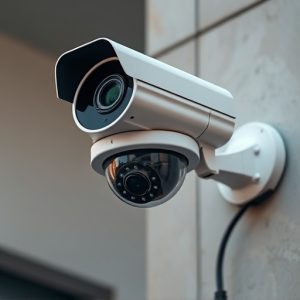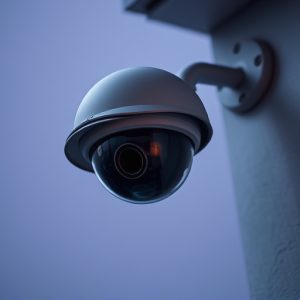Unmasking Fraud: Detecting & Preventing Fake Security Camera Mounting Brackets
In today's digital era, fake security camera mounting brackets pose a significant threat to hom…….
In today's digital era, fake security camera mounting brackets pose a significant threat to home and business security systems. These counterfeit brackets can undermine the entire setup's integrity, offering poor stability and inferior materials that are more susceptible to damage or theft. Genuine brackets ensure optimal positioning, strength, and quality control. Outdoor models provide flexible weatherproof options for wide-area coverage, while professionals use visual inspections, specialized tools, and technology like 3D scanning to detect fakes. Using fake brackets can lead to camera dislodgement, material failure, and surveillance gaps, with critical installations facing severe consequences. Protecting against tampering involves using locked reinforced brackets, regular inspections, motion sensors, and alarm systems for continuous system reliability and asset safety.
“In the realm of home and business security, fake security camera mounting brackets pose a subtle yet significant threat. This comprehensive guide, ‘Understanding Fake Security Camera Mounting Brackets: A Comprehensive Overview,’ delves into the insidious world of these counterfeit components. We explore common types, their applications, and advanced detection methods to identify false brackets. Furthermore, we analyze their impact on system integrity, potential safety risks, and offer preventative measures for strengthening surveillance systems against such threats.”
- Understanding Fake Security Camera Mounting Brackets: A Comprehensive Overview
- Common Types and Their Applications in Home and Business Security
- Detection Methods for Identifying False Mounting Brackets
- The Impact on System Integrity and Potential Risks to Safety
- Preventative Measures and Best Practices for Securing Your Surveillance System
Understanding Fake Security Camera Mounting Brackets: A Comprehensive Overview
Fake Security Camera Mounting Brackets have become a prevalent concern in today’s digital era, where surveillance systems are increasingly common. These brackets, designed to hold security cameras in place, can be manipulated or replaced by counterfeit versions, compromising the integrity of your security setup. Understanding the intricacies of these brackets is crucial for maintaining effective security measures.
While genuine mounting brackets ensure optimal camera positioning and stability, their fake counterparts often lack quality control. They may not securely attach to walls or ceilings, leading to misaligned cameras that fail to capture clear footage. Moreover, counterfeit brackets could be made from inferior materials, making them prone to damage or theft, further weakening the security system’s overall effectiveness.
Common Types and Their Applications in Home and Business Security
Fake security camera mounting brackets come in various types, each designed for specific applications to enhance home and business security. One common type is the wall-mounted bracket, ideal for indoor use as it allows for discrete placement of cameras near entry points, windows, or valuable areas. These brackets are often made from sturdy materials like metal or high-quality plastic, ensuring stability and durability.
For outdoor surveillance, adjustable and weatherproof mounting brackets are popular choices. They can be installed on walls, ceilings, or poles, providing flexible camera positioning to capture wide areas such as parking lots, perimeter fences, or exterior entry points. These brackets withstand harsh weather conditions, making them suitable for both residential and commercial settings that require 24/7 outdoor security monitoring.
Detection Methods for Identifying False Mounting Brackets
The detection of fake security camera mounting brackets is a critical aspect of maintaining the integrity of surveillance systems. One common method involves visual inspection, where professionals look for inconsistencies in the bracket’s design, material, and construction quality. This can include checking for inferior metal quality, visible manufacturing defects, or unusual finishing touches that might indicate an imitation product. Additionally, security experts often utilize specialized tools to measure the physical dimensions of the brackets, ensuring they match genuine manufacturers’ specifications precisely.
Technology also plays a significant role in identifying fakes. Advanced imaging techniques, such as 3D scanning and high-resolution photography, can capture detailed images that reveal subtle differences between real and fake brackets. Furthermore, some systems employ computer vision algorithms to analyze these images, automatically flagging anomalies and potential counterfeits. These methods are crucial for both initial installation checks and ongoing maintenance, ensuring that the security camera system remains reliable and effective.
The Impact on System Integrity and Potential Risks to Safety
The use of fake security camera mounting brackets can have severe implications for system integrity and safety. These inferior substitutes are often designed to mimic genuine brackets, but they lack the quality and durability required to support cameras securely. As a result, poorly made brackets may fail under stress, leading to camera dislodgement during attempted theft or harsh weather conditions. This not only compromises the security system’s effectiveness but also poses potential risks to people and property below, as falling cameras can cause damage or injury.
Moreover, fake mounting brackets might be made from substandard materials that are susceptible to corrosion or deterioration over time. This can lead to unstable camera positions and even unexpected failures, creating blind spots in surveillance coverage. In critical security installations, such as banks, hospitals, or high-traffic areas, these issues can have grave consequences. Therefore, it’s essential to invest in genuine, high-quality brackets to maintain system integrity and ensure the safety of individuals and assets they protect.
Preventative Measures and Best Practices for Securing Your Surveillance System
Protecting your surveillance system from tampering is a crucial aspect of maintaining effective security measures. One common vulnerability is the use of fake security camera mounting brackets, which can be easily replaced or removed by determined individuals. To counter this, it’s essential to employ robust and secure mounting solutions that are designed specifically for security cameras. Look for brackets with features like locking mechanisms, bolt reinforcements, and weatherproof seals to prevent unauthorized access.
Best practices include regular inspections of the mounting hardware to ensure all components are secure and intact. Additionally, consider implementing additional security measures such as motion sensors or alarm systems that trigger when brackets or cables are tampered with. By adopting these preventative measures, you enhance the integrity of your surveillance system, ensuring its continuous effectiveness in monitoring and protecting your property.
Fake security camera mounting brackets pose a significant threat to surveillance system integrity, potentially compromising safety and privacy. By understanding their common types, learning detection methods, and implementing preventative measures like regular system audits and secure hardware installation, homeowners and businesses can fortify their security landscapes. Staying vigilant against these deceptive devices is key to maintaining the reliability of your security system in today’s digital era.


